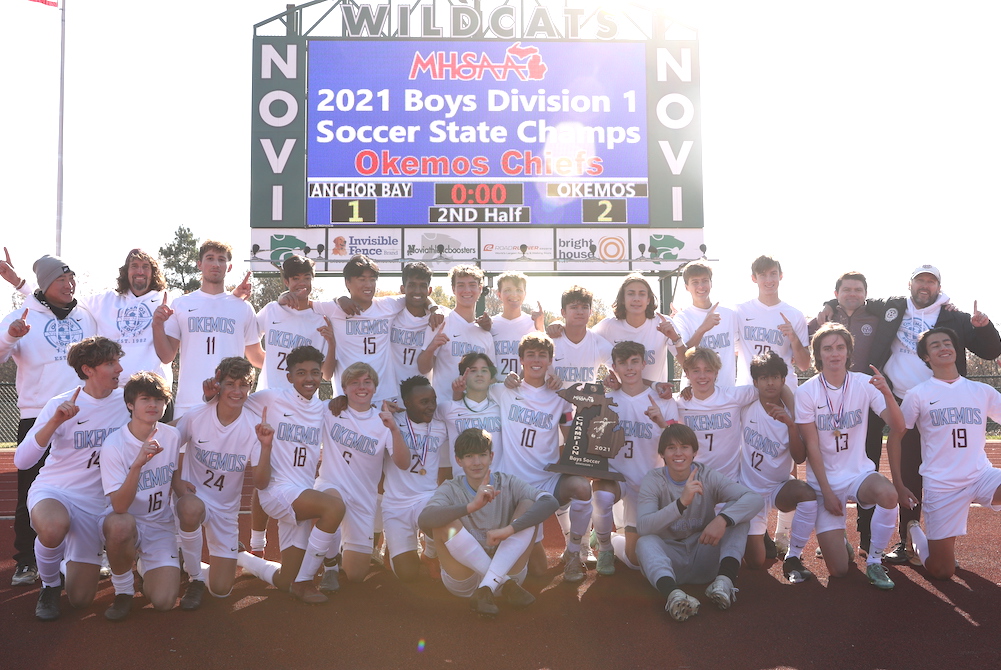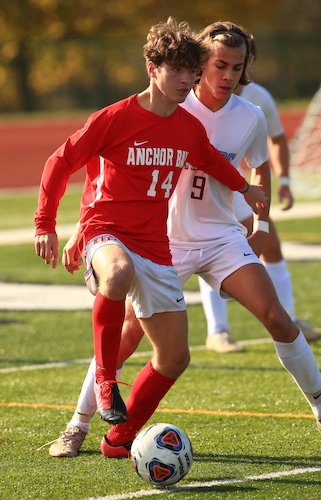
Notre Dame Prep Sets Pace Early, Holds On Late to Finish 1st Title Run
By
Paul Costanzo
Special for MHSAA.com
November 2, 2024
GRAND LEDGE – For 10 years, Rob Suffredini has been chasing the ultimate goal of a boys soccer Finals title with Pontiac Notre Dame Prep.
After the Fighting Irish achieved that Saturday with a wild 3-2 victory against Elk Rapids in the Division 3 championship match, he was thrilled, but also left wondering what to do next.
“I’m still kind of trying to process all this,” Suffredini said. “We chased it, we caught it, now what? There’s no practice tomorrow, there’s no team to get ready for. It’s a sense of relief, especially how this game ended.”
The Irish jumped out to a 3-0 halftime lead and held on down the stretch to claim the first title in program history. They had made one trip to the Finals previously, finishing as Division 3 runners-up in 2000.
“It’s awesome to make history for my school,” said NDP senior forward Will Lanham, who had one goal and one assist. “It just means a lot, especially with all of my peers, the whole school, the athletic director and everybody (here). It’s great to finally win it for the school.”
 Notre Dame Prep finished the season 23-2 despite playing one of the toughest schedules in the state. It’s a final record that even surprised Suffredini, but the competitive slate achieved exactly what he’d hoped.
Notre Dame Prep finished the season 23-2 despite playing one of the toughest schedules in the state. It’s a final record that even surprised Suffredini, but the competitive slate achieved exactly what he’d hoped.
“I really think that schedule, those level opponents and the pace of play that we played, (the Elks) weren’t really ready for it until they got acclimated,” Suffredini said. “Then they started getting into the game, but at that point we were up by three goals, thankfully.”
NDP made its presence felt early in the game, testing Elk Rapids keeper Jacob McManus from distance on a pair of shots during the opening 10 minutes.
The second shot, a rocket from junior midfielder Jack Kilpatrick, was brushed well wide by McManus, but Daniel Lebanion was able to get it under control on the left wing and send a cross toward the front of the goal where Ben Liparoto was able to deflect it into the goal and give his team a 1-0 lead with 31:33 to play in the first half.
Lanham doubled the lead 10 minutes later, taking a pass from Lebanion, splitting a pair of defenders outside the box before finding his footing and going to the far post for his 29th goal of the season.
Late in the first half, Lanham would get his 15th assist of the year, sending a cross into the box that Liparoto rose to meet with a well-placed header with 5:52 remaining
 “We went out there, we gave everything we had,” Lanham said. “We have a rule: First 10 minutes, give it everything you’ve got in the game – intensity high – and we got three goals in the first half. We just came out flying.”
“We went out there, we gave everything we had,” Lanham said. “We have a rule: First 10 minutes, give it everything you’ve got in the game – intensity high – and we got three goals in the first half. We just came out flying.”
The gap in level of play early was also evident to Elk Rapids coach Nate Plum.
“We got to see for the first time the true talent on that other team,” Plum said. “It’s one thing to see it on video, it’s another thing to see – they don’t click off, so you have to give it to the other team.”
The Elks did find their footing late, though, and managed to make the Irish sweat over the final 10 minutes.
“We talked a lot about heart and grit in the locker room, that’s kind of what’s gotten us to this point,” Plum said. “I think you saw the heart come through, at the end. I wish we could take back a couple of those things, and I think our boys would say the same. A lot of emotion goes into this game. I’m proud of the way we finished; we never gave up.”
Elk Rapids got on the board with 10:06 to play, as Tyler Standfest scored on a flick header over Tomassino Offer who had come off his line to handle the free kick. The service came from Noah Bogard, who lofted his kick toward the penalty spot from about 45 yards out.
That was followed by steady Elk Rapids pressure, as it looked to draw level. The Elks nearly pulled to within a goal with six minutes remaining, when a header from Carter Denoyer went just wide.
Tempers flared not long after, with an Elk Rapids player shown a red card for a post-whistle foul on an NDP player who had just received a yellow. A second Elks player then was shown a second yellow, ending the match for him with 4:47 to play.
Even with nine players, the Elks were able to pull within one score with 32 seconds remaining on a goal from Jayden Hresko, which was assisted by Standfest.
“High school sports, man, and sports in general,” Suffredini said. “I give them a lot of credit. It just took a spark. It was unnerving. Those four minutes couldn’t go any slower, in my opinion.”
PHOTOS (Top) Notre Dame Prep’s Benjamin Liparoto (2) heads a shot past the last lines of Elk Rapids’ defense for the first goal of the Division 3 Final on Saturday. (Middle) NDP’s Will Lanham (10) works to gain possession against Elk Rapids’ Jonah DenHerder and Jake Garrow (14). (Below) The Elks’ Tyler Standfest heads a shot that gets past Fighting Irish keeper Tomassino Offer. (Photos by Adam Sheehan/Hockey Weekly Action Photos.)

Okemos Finds Scoring Touch, Championship Stride in Comeback Win
By
Perry A. Farrell
Special for MHSAA.com
November 6, 2021
NOVI – For three quarters of the Division 1 championship match Saturday at Novi High School, undefeated Okemos’ offense was lifeless against New Baltimore Anchor Bay.
The Tars paid close attention to Jack Guggemos, and the Chiefs had no answers until suddenly, their preparation for a late-game, must-score scenario played out with a dream result.
Down by a goal, Okemos (20-0-4) scored two within two minutes, 17 seconds of each other during the final 10 minutes to claim its third Finals title in a physical 2-1 victory.
Ben Hussey scored off a great assist from Guggemos to tie the game at 1-1, and Aidan Antcliff scored the game-winner on a free kick from 20 yards out with seven minutes, 42 second to play.
“I just tried to get to the end line, and Ben was there,’’ said Guggemos. “He made a great run to the box and tapped it in. You have to deal with what’s thrown at you.
Guggemos had a lot to live up to. His coach and father, Brian, won a Class B title as a senior at Mason in 1989.
“No pressure, right,’’ Jack said, laughing. “It’s a great feeling being able to celebrate this with him.’’
Antcliff knew his shot was in once he booted it.
“It’s an unbelievable feeling,’’ said Antcliff, who scored just his second goal of the year. “It was a great shot. I practice that shot in the summertime. I got the opportunity in this game, and I made the most of it. Once I hit it, I knew it was going in.’’
 Anchor Bay (22-2-1) made its first appearance in Final, while Okemos won the 2004 Division 1 title and was the B-C champ in 1984.
Anchor Bay (22-2-1) made its first appearance in Final, while Okemos won the 2004 Division 1 title and was the B-C champ in 1984.
Okemos was led by all-state senior Guggemos, who set the school record with 45 goals this fall. Anchor Bay featured three past all-state players in Tanner Hodgson (first team), twin brother Carson Hodgson (second team) and goalie Evan Linsley (second team).
The Tars made sure Guggemos was surrounded any time he had the ball, sometimes with as many as three defenders.
“He was part of our game plan,’’ said Tars coach Nate Williams.
“It was a great game between two great soccer teams. We knew even up 1-0 we couldn’t take our foot off the gas.’’
Neither team generated offense in the first half, with most play at mid-field.
With 2:03 left in the first half, junior midfielder Francesco DiLorenzo blasted a shot past the Okemos keeper to give the upstart Tars a 1-0 lead heading into halftime.
Anchor Bay came out even more aggressive in the second half with the lead and a chance at the state title.
Guggemos was shackled, but he got free to send a pass near the net with 9:59 left that Hussey redirected into the net to tie the game at 1-1.
“It’s funny because my assistant coaches were talking about it,’’ said Okemos coach Brian Guggemos. “I’ve been doing it long enough to know you need to prepare for moments where you’re going to be down a goal. In the last three weeks we’ve practiced being down a goal. We’ve tried to make sure we were prepared for it. We said look, if we’re down a goal here’s the formation. We went into it right away, and then I told Ben and Owen (Brewer), our two forwards, get in there and crash the goal. That obviously turns the game around a little bit.
"Aidan hits a banger to win the state championship. We also practice those things everyday this time of the year. The guys have listened to the things we needed to do in practice. They paid attention, and that attention to detail has been pretty good for us."
PHOTO (Top) Okemos celebrates its first Finals championship since 2004 on Saturday. (Middle) Anchor Bay's Tanner Hodgson (14) works to control possession with Okemos' Ben Hussey defending. (Photos by Hockey Weekly Action Photos.)

